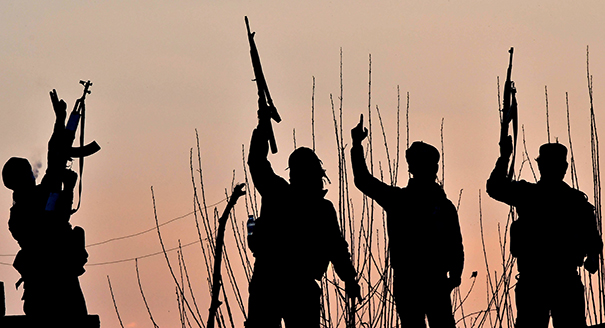The recent capture of Baghouz, the last Islamic State stronghold in Syria, was celebrated as a defining moment in the costly war against a group responsible for the death of tens of thousands of people in recent years.
While the victory was hailed as a blow against terrorism by U.S. and Kurdish forces, others welcomed it for different reasons. Hurras al-Din, the Al-Qa‘eda-affiliated jihadi group in Syria’s Idlib Governorate, saw it as a golden opportunity to recruit committed and well-trained fighters. This could allow it to expand its presence in Syria, and beyond that into Iraq. Hurras al-Din is an offshoot of Hay’at Tahrir al-Sham, the dominant jihadi group in Idlib that was originally named Jabhat al-Nusra. Jabhat al-Nusra had declared its allegiance to Al-Qa‘eda, but later severed the relationship in a maneuver aimed at dealing with shifting power dynamics in Idlib. That decision reflected a relative pragmatism that has contrasted with the behavior of the Islamic State and Hurras al-Din.
Hurras al-Din enjoys a relatively safe operational space in Hay’at Tahrir al-Sham-dominated areas. However, it does not subscribe to Hay’at Tahrir al-Sham’s politics, specifically its appeasement of Turkey which has reached understandings with Russia. Hurras al-Din’s unwillingness to compromise as well as its less accommodating Salafi-jihadi ideology, allegiance to Al-Qa‘eda’s central leadership, and leaders’ legacy have lent credibility to the group among jihadis. The organization’s core leadership has a long history of fighting with Al-Qa‘eda. The most prominent of these are the military leader Samir Hijazi, a Syrian known as Abou Humam al-Shami, and the Jordanian Sami al-‘Aridi, the group’s religious leader. Their experiences fighting in Afghanistan and Iraq have improved their chances of attracting hardened Islamic State fighters on the run.
Since its formation early in 2018, Hurras al-Din has positioned itself to attract Islamic State recruits as the group lost territory. The Islamic State probably anticipated this charm offensive and last summer warned members against joining Hurras al-Din. It referred to the group as “the guardians of apostates” and called its cadres “stooges in the hands of Golani,” a reference to the emir of Hay’at Tahrir al-Sham, Abou Mohammed al-Golani.
While Hurras al-Din’s members were part and parcel of Hay’at Tahrir al-Sham’s leadership during its conflict with the Islamic State, they expressed solidarity with the Islamic State as it fought its last battles against the Kurdish-led Syrian Democratic Forces, backed by the United States military. In a widely circulated video they also voiced admiration for the Islamic State’s perseverance in fighting “to the last gasp” in Baghouz. The Islamic State, according to the video, did not use “God’s religion” to appease, a reference to Hay’at Tahrir al-Sham’s behavior with regard to Turkey. A previous video had shown Hay’at Tahrir al-Sham’s combatants informing Hurras al-Din militants, much to their displeasure, that a Turkish observation post would be constructed on their position.
Tensions were exacerbated in February after Hay’at Tahrir al-Sham arrested two members of Hurras al-Din, including a Libyan, in Kfar Zita near Idlib city. After a number of such incidents the two groups signed a six-point deal to cease mutually hostile media campaigns, return captured weapons to each group, and halt the defection of militants from both sides.
Hurras al-Din is not only competing with Hay’at Tahrir al-Sham over territory and fresh recruits, but also alliances. ‘Aridi has written recently in support of the Uyghur Turkestan Islamic Party. The party’s emir, Abdul Haq al-Turkestani, has called on Salafi-jihadi ulama, including Al-Qa‘eda leader Ayman al-Zawahiri, to support the Uyghur struggle in the face of increasing Chinese repression and the internment of nearly 1 million Uyghurs in so-called reeducation camps in China’s northwestern Xinjiang Province. This is significant as the Turkestan Islamic Party is a major ally of Hay’at Tahrir al-Sham. It has proven indispensable in Hay’at Tahrir al-Sham’s conflict with Turkish-backed local factions in Idlib Governorate as well as in Rural Hama and Rural Aleppo Governorates.
However, despite the tensions Hurras al-Din continues to pursue an ambitious expansion to different parts of Syria and, most importantly, Iraq. Numerous reports on the expansion of the group to Iraq have emerged in the past two weeks, with some Iraqi officials denying this, and others warning of it. There are allegations that Hurras al-Din has entered Anbar Governorate, where the group is claiming to protect Sunnis against the Shi‘a-dominated Popular Mobilization Forces. While still unconfirmed, such an expansion may be inevitable and will have to be measured in the number of attacks conducted, as Hurras al-Din seems less keen on taking land as was the case with the Islamic State and Jabhat al-Nusra. The group, instead, has focused on capacity building through training and recruitment and the adoption of hit and run tactics.
This long-term scheme will assist Hurras al-Din in reinforcing its presence in Iraq, where Sunni grievances persist. The group is wagering that by gaining credibility as a transnational group, defections from Hay’at Tahrir al-Sham toward Hurras al-Din will increase, helping to revive the Al-Qa‘eda model—one that is both lethal and invisible.








